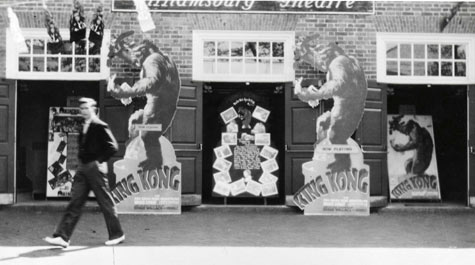The movies come to Williamsburg (and vice versa)
The Global Film s-GIG hit the ground running, scheduling its first film program for mid-February at Williamsburg’s Kimball Theatre.
The event, When the Movies Come to Town: Williamsburg and Film History, not only examined the role that local movie houses served as portals to culture, but celebrate the longevity and service of the Kimball itself. GIGs--Global Inquiry Groups--are William & Mary's academic incubators, interdisciplinary and collaborative initiatives kick-started by the College's Wendy and Emery Reves Center for International Studies.
“January 2008 is the 75th anniversary of the Kimball Theatre, which until 2001 was called the Williamsburg Theatre,” explained Arthur Knight. “The Kimball has run—with very short interruptions for cleaning and painting and then the larger renovation of two years ago—for 75 years. In a small town, this is fairly exceptional.”
Knight is director of William and Mary’s Film Studies Program and an associate professor connected with both the English and American studies departments. Other coordinators of the Global Film s-GIG are Christy Burns, associate professor of English, and Timothy Barnard, a visiting assistant professor of American studies and English.
Like the mercury group, the Global Film s-GIG grew out of an exploratory e-GIG venture that included 11 faculty members. The February Kimball event is the first of what is expected to be an annual film event, which, Burns stresses, differs from a film festival.
Not just movies
“They are like film festivals but instead of just showing films we also bring in scholars who are expert on a particular field. We usually try to bring in filmmakers themselves to talk about the making of the films.”
In programming the event, Burns said the coordinators intend to expand on the successful formula characterized by the late September visit of Andrew Higson, an English scholar who specializes in the national cinema of Britain.
“He visited classes. He gave a major talk and we had a screening of A Constant Gardener,” Burns said. “We also had him in a seminar and he went out to dinner with some of the faculty. So we really did everything we could have and he was very gracious and really enjoyed it as far as I could tell. He also conducted a faculty seminar on theories of national cinema and went out to dinner with us afterwards. So his visit reached the general public, our students and faculty, all in a variety of ways.”
She pointed out that the larger film events will involve multiple screenings and multiple speakers. Directors and scholars coming to these events will be more focused on giving talks and leading public discussions after the films, making the events scholarly and accessible at the same time.
“That’s a high demand to make on a speaker, but we will let them know that we wish to serve Williamsburg’s extensive and intelligent retirement community as well as our undergraduate population.” she said. “As for the students, they can often follow these talks at a high level of intellectual challenge, although speakers will know that some students will be prepared from courses and others will walk in as regular audience.”
The schedule for the first film event is coalescing around a number of film screenings supplemented by one or more lectures, discussions or other contextual presentations. Barnard teaches Cinema and the Modernization of U.S. Culture and has developed an “add on” course involving a number of students who have begun conducting movie-based oral history surveys among Williamsburg residents. The organizers intend to use the students’ oral histories as a basis for writing the program notes. The event, like the oral histories being compiled, will meld entertainment with serious scholarship.
Big screen/big issues
“We’re trying on the one hand, to represent the history of the theatre and the things that have been programmed in the theatre over the 75 years,” Knight said. “So we want the overall spirit of the event to be attractive, light—celebratory I suppose—but we also don’t want to lose sight of the fact that the movies have been a place where Americans have really wrestled with big issues. Sometimes they are kind of big abstract issues like war or legends about your country—the West and the like. But sometimes the issues are much more direct, segregation being the obvious one in lots of places, certainly in Williamsburg.”
Knight said that the Williamsburg Theatre didn’t admit African American patrons until the 1950s or early 1960s, and so the local moviehouse might not have the same set of positive associations among all members of the Williamsburg community today. One element of the program will, in part, address segregation at the movies and include screenings of In the Heat of the Night and Gone with the Wind.
DOG Street goes ape
The film event will show a lighter side of Williamsburg’s past, as well. Knight said the group obtained a still photo of Duke of Gloucester Street from 1933. “We think of that little stretch of Duke of Gloucester Street as a high class, pristine block that’s very controlled in its atmosphere,” Knight said. “Well this photograph shows that the ballyhoo for the showing of King Kong was two large painted flats of King Kong on either side of the doors that were like about a story and a half high and a big banner across the front that said ‘King Kong Comes to Town,’ or something like that. Tim and I and the students are all very fond of this image because it shows a slightly more—I’m trying to think of the right adjective—rough and tumble, low brow, kind of Duke of Gloucester Street than maybe what we feel like we often encounter now.”
The s-GIG participants intend to present regular film events,
usually with a global theme and often focusing on national films. Burns
mentioned that the theme for the next film event may be Bollywood. 
















